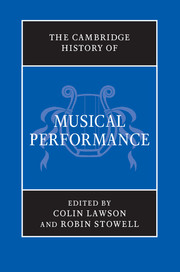Book contents
- Frontmatter
- PART I PERFORMANCE THROUGH HISTORY
- PART II PRE-RENAISSANCE PERFORMANCE
- PART III PERFORMANCE IN THE RENAISSANCE (C. 1430–1600)
- PART IV PERFORMANCE IN THE SEVENTEENTH CENTURY
- PART V PERFORMANCE IN THE ‘LONG EIGHTEENTH CENTURY’
- PART VI PERFORMANCE IN THE NINETEENTH CENTURY
- 24 Performance in the nineteenth century: an overview
- 25 Vocal performance in the nineteenth century
- 26 Instrumental performance in the nineteenth century
- 27 Case study: Richard Wagner, Tristan und Isolde
- PART VII THE TWENTIETH CENTURY AND BEYOND
- PART VIII
- Index
24 - Performance in the nineteenth century: an overview
from PART VI - PERFORMANCE IN THE NINETEENTH CENTURY
Published online by Cambridge University Press: 28 March 2012
- Frontmatter
- PART I PERFORMANCE THROUGH HISTORY
- PART II PRE-RENAISSANCE PERFORMANCE
- PART III PERFORMANCE IN THE RENAISSANCE (C. 1430–1600)
- PART IV PERFORMANCE IN THE SEVENTEENTH CENTURY
- PART V PERFORMANCE IN THE ‘LONG EIGHTEENTH CENTURY’
- PART VI PERFORMANCE IN THE NINETEENTH CENTURY
- 24 Performance in the nineteenth century: an overview
- 25 Vocal performance in the nineteenth century
- 26 Instrumental performance in the nineteenth century
- 27 Case study: Richard Wagner, Tristan und Isolde
- PART VII THE TWENTIETH CENTURY AND BEYOND
- PART VIII
- Index
Summary
Introduction
The nineteenth century saw a greater transformation in musical life than any period before or – setting aside recording and marketing – since. It links the still easily recognisable patterns of early twentieth-century public music-making with a now totally vanished world of privileged and predominantly localised activity: a world that could never have conceived of the breadth of musical activity to come, symbolised in the emergence of the public concert as the new focus of quality music-making, usurping the traditional role of court and church. This change came about through major shifts in social structure subsequent upon the economic changes wrought by industrialisation and commerce, and the political reform towards greater independence in many spheres – and associated in the arts with the Romantic movement. But though it is impossible to prioritise the influence of artistic creativity and that of the society of which it is a part in effecting change, it is the circumstances of musical life that are the more tangible in considering musical performance.
The century is naturally divided by the revolutionary events of 1848, anticipating the increasing economic expansion and stability after 1870 – an age of hitherto unknown levels of investment and economic growth and consequently of personal wealth and municipal expansion. It did not, however, announce the equality of opportunity for the common man of which social reformers had dreamt: that would have to wait for the development of a grass-roots socialist movement with political muscle taking real effect only after 1900. Rather, the ascendant political liberalism was embodied in the wider consolidation of a new affluent and aspirant middle class that increasingly took over the responsibility for cultural life from the nobility. The achievements of this class and the growing importance to them of music and the musical profession underpin the world of musical performance in the nineteenth century.
- Type
- Chapter
- Information
- The Cambridge History of Musical Performance , pp. 575 - 610Publisher: Cambridge University PressPrint publication year: 2012



